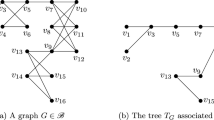Abstract
Let Φ(u × v, k, λ a , λ c ) be the largest possible number of codewords among all two-dimensional (u × v, k, λ a , λ c ) optical orthogonal codes. A 2-D (u × v, k, λ a , λ c )-OOC with Φ(u × v, k, λ a , λ c ) codewords is said to be maximum. In this paper, the number of codewords of a maximum 2-D (u × v, 4, 1, 3)-OOC has been determined.
Similar content being viewed by others
References
R J R Abel, M Buratti. Some progress on (v, 4, 1) difference families and optical orthogonal codes, J Combin Theory Ser A, 2004, 106: 59–75.
T L Alderson, K E Mellinger. Geometric constructions of optimal optical orthogonal codes, Adv Math Commun, 2008, 2: 451–467.
T L Alderson, K E Mellinger. Families of optimal OOCs with λ = 2, IEEE Trans Inform Theory, 2008, 54: 3722–3724.
T L Alderson, K E Mellinger. 2-dimensional optical orthogonal codes from Singer groups, Discrete Appl Math, 2009, 157: 3008–3019.
M Buratti. Cyclic designs with block size 4 and related optimal optical orthogonal codes, Des Codes Cryptogr, 2002, 26: 111–125.
H Cao, R Wei. Combinatorial constructions for optimal two-dimensional optical orthogonal codes, IEEE Trans Inform Theory, 2009, 55: 1387–1394.
Y Chang, R Fuji-Hara, Y Miao. Combinatorial constructions of optimal optical orthogonal codes with weight 4, IEEE Trans Inform Theory, 2003, 49: 1283–1292.
Y Chang, L Ji. Optimal (4up, 5, 1) optical orthogonal codes, J Combin Des, 2004, 12: 346–361.
Y Chang, Y Miao. Constructions for optimal optical orthogonal codes, Discrete Math, 2003, 261: 127–139.
Y Chang, J Yin. Further results on optimal optical orthogonal codes with weight 4, Discrete Math, 2004, 279: 135–151.
W Chu, C J Colbourn. Optimal (v, 4, 2)-OOC of small orders, Discrete Math, 2004, 279: 163–172.
F R K Chung, J A Salehi, V K Wei. Optical orthogonal codes: design, analysis and applications, IEEE Trans Inform Theory, 1989, 35: 595–604.
T Feng, Y Chang, L Ji. Constructions for strictly cyclic 3-designs and applications to optimal OOCs with λ = 2, J Combin Theory Ser A, 2008, 115: 1527–1551.
Y Huang, Y Chang. Two classes of optimal two-dimensional OOCs, Des Codes Cryptogr, 2012, 63: 357–363.
Y Huang, Y Chang. Optimal (n, 4, λ, 3) optical orthogonal codes, Discrete Math, 2012, 312: 3128–3139.
Y Huang, J Zhou. A class of 2-dimensional optimal optical orthogonal codes with weight four, J Beijing Jiaotong Univ, 2012, 6: 144–146.
S Ma, Y Chang. A new class of optimal optical orthogonal codes with weight five, IEEE Trans Inform Theory, 2004, 50: 1848–1850.
S V Maric, O Moreno, C Corrada. Multimedia transmission in fiber-optic LANs using optical CDMA, J Lightwave Technol, 1996, 14: 2149–2153.
K Momihara, M Buratti. Bounds and constructions of optimal (n, 4, 2, 1) optical orthogonal codes, IEEE Trans Inform Theory, 2009, 55: 514–523.
J A Salehi. Code division multiple-access techniques in optical fiber networks-Part I: Fundamental principles, IEEE T Commun, 1989, 37: 824–833.
J A Salehi, C A Brackett. Code division multiple-access techniques in optical fiber networks-Part II: Systems performance analysis, IEEE T Commun, 1989, 37: 834–842.
E S Shivaleela, A Selvarajan, T Srinivas. Two-dimensional optical orthogonal codes for fiber-optic CDMA networks, Lightwave Technol, 2005, 23: 647–654.
J Wang, X Shan, J Yin. On constructions for optimal two-dimentional optical orthogonal codes, Des Codes Cryptogr, 2010, 54: 43–60.
X Wang, Y Chang. Further results on optimal (v, 4, 2, 1)-OOCs, Discrete Math, 2012, 28: 331–340.
J Yin. Some combinatorial constructions for optical orthogonal codes, Discrete Math, 1998, 185: 201–219.
Author information
Authors and Affiliations
Corresponding author
Additional information
Supported by the National Natural Science Foundation of China (61071221,10831002).
Rights and permissions
About this article
Cite this article
Huang, Ym., Chang, Yx. Maximum two-dimensional (u × v, 4, 1, 3)-OOCs. Appl. Math. J. Chin. Univ. 28, 279–289 (2013). https://doi.org/10.1007/s11766-013-3064-3
Received:
Published:
Issue Date:
DOI: https://doi.org/10.1007/s11766-013-3064-3



